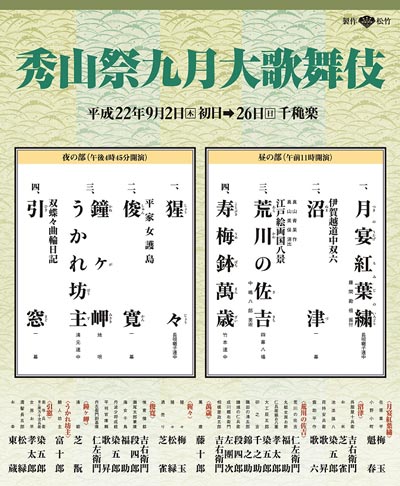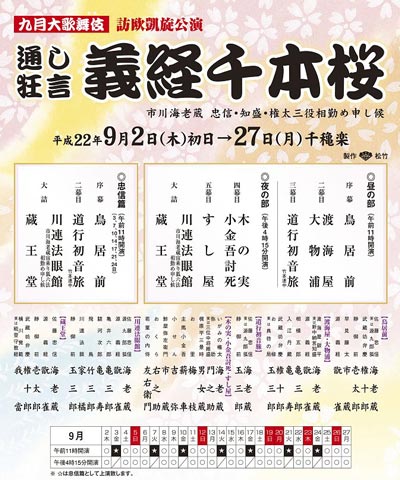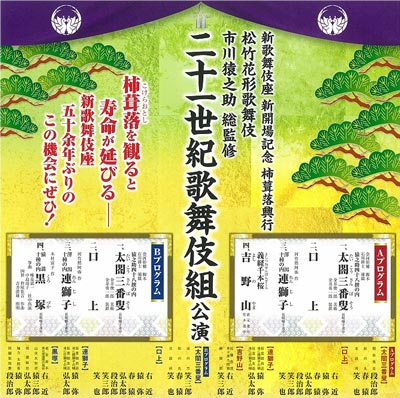| SEPTEMBER 2010 |
|
2 shows in T˘ky˘ (Shinbashi Enbuj˘), 2 shows in ďsaka (Shinkabukiza), 3 in Ky˘to (Minamiza), 1 in Nikk˘ (T˘sh˘gű) and 2 tours (Western Provinces, Kinshű Tokubetsu K˘en)!
|
| Shinbashi Enbuj˘ (T˘ky˘) |
| Dates | 2 ~ 26 September 2010 (Shűzan Matsuri Kugatsu ďkabuki) Shűzan's Festival September Grand Kabuki |
| MatinÚe |
Tsuki no Utage Momiji no Irodori Igagoe D˘chű Sugoroku (Numazu) Arakawa no Sakichi Kotobuki Umebachi Manzai |
| Evening |
Heike Nyogo no Shima (Shunkan) Kane no Misaki |
| Casting |
Nakamura Kichiemon, Kataoka Nizaemon, Sakata T˘jűr˘, Nakamura Tomijűr˘, Nakamura Shikan, Nakamura Shibajaku, Nakamura Baigyoku, Nakamura Kaishun, Nakamura Fukusuke, Ichikawa Danshir˘, Ichikawa Sadanji, Nakamura Kinnosuke, Kataoka Takatar˘, Nakamura T˘z˘, Nakamura Karoku, Nakamura Kash˘, Onoe Sh˘roku, Ichikawa Somegor˘, Kataoka Sennosuke |
| Comments |
This is the 4th edition of a special program called "Shűzan Matsuri" (the festival of Shűzan), which is produced at the Shinbashi Enbuj˘ to commemorate the great actor Nakamura Kichiemon I, whose's haimy˘ was Shűzan. The star of this program is his adopted son Nakamura Kichiemon II.
|
 |
|
|||
| Dates | 2 ~ 27 September 2010 (Kugatsu ďkabuki) September Grand Kabuki |
||
| MatinÚe |
|
||
| Evening |
|
||
| Special Tadanobu |
|
||
| Casting |
Ichikawa Ebiz˘, Band˘ Tamasabur˘, Kataoka Gat˘, Nakamura Kanjaku, ďtani Tomoemon, Kataoka Ichiz˘, Ichikawa Unosuke, Kamimura Kichiya, Band˘ Takesabur˘, Kawarasaki Gonjűr˘, Ichimura Kakitsu, Ichikawa Monnosuke, Ichikawa Omez˘, Band˘ Shinsha, Band˘ Kamesabur˘, Band˘ Kametoshi, Nakamura Baishi, Nakamura Kazutar˘ |
||
| Comments |
A t˘shi ky˘gen production of the "Yoshitsune Senbon Zakura", starring Ichikawa Ebiz˘ in the three major male roles of this drama (Tadanobu, Tomomori, Gonta) and Band˘ Tamasabur˘ in the role of Shizuka Gozen. The MatinÚe and the Evening programs are staged for most of the days. The 3rd, the 7th, the 10th, the 14th, the 17th, the 21st and the 24th of September, the "Special Tadanobu" is staged instead of the two usual programs.
|
||
 |
| Shinkabukiza (ďsaka) |
| Dates | 3 ~ 22 September 2010 (Kokera Otoshi Sh˘chiku Hanagata Kabuki) |
| Program A | |
| Program B | |
| Casting |
Ichikawa Ukon, Ichikawa Danjir˘, Ichikawa Emiya, Ichikawa Emisabur˘, Ichikawa Shun'en, Ichikawa En'ya, Ichikawa K˘tar˘ |
| Comments |
This program is in fact the kokera otoshi of the newly-relocated ďsaka Shinkabukiza, which was moved from Nanba (Chű˘ Ward in ďsaka) to a mixed-use building in Uehonmachi.
|
 |
| Kabuki Tour in the western provinces | |
| Dates | 31 August ~ 25 September 2010 |
| Program |
Kabuki no Mikata |
| Casting | |
| Comments |
|
| T˘sh˘gű (Nikk˘) | |
| Dates | 18 September 2010 (T˘sh˘gű H˘n˘ Kabuki) T˘sh˘gű Offering Kabuki |
| Program | |
| Casting | |
| Comments |
A special Kabuki performance with 2 young actors within the precincts of the famous T˘sh˘gű shrine in Nikk˘, where is enshrined Tokugawa Ieyasu, who was the founder and first Sh˘gun of the Tokugawa Shogunate.
|
| Kinshű Tokubetsu K˘en | |
| Dates | 8 ~ 24 September 2010 |
| Program |
Geidan Ayame Yukata Urashima |
| Casting | |
| Comments |
Kinshű means Autumn Brocade and this short dance-oriented tour is led by Nakamura Kanzabur˘'s sons, Nakamura Kantar˘ and Nakamura Shichinosuke. The first item (geidan) in this program is a talk. All the others items are dances.
|
|
|
| Contact | Main | Top | Updates | Actors | Plays | Playwrights | Programs | Links | FAQ | Glossary | Chronology | Illustrations | Prints | Characters | Derivatives | Theaters | Coming soon | News |